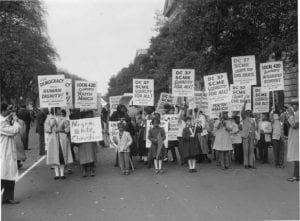For my dissertation, I am planning to research women’s role in the civil rights movement, and their role in the different civil right groups such as the SCLC, the SNCC, Malcolm X’s black nationalist movement and the Black Panthers.
Primary Sources
There are a few different primary sources I would like to look at it, which include newspapers, personal memoirs, photographs and newspapers from certain civil rights groups.
1.Photograph 306-SSM-4D-73-10; Photograph of the Civil Rights March on Washington; 8/28/1963; Miscellaneous Subjects, Staff and Stringer Photographs, 1961 – 1974; Records of the U.S. Information Agency, Record Group 306; National Archives at College Park, College Park, MD. [Online Version, https://www.docsteach.org/documents/document/we-march, January 30, 2021]

This a photo of the March on Washington in 1963, I found this photo from the national archives, while doing some research. I think this photo gives a good insight into there participation in the different groups in the civil rights movement.
2.https://www.marxists.org/history/usa/pubs/black-panther/index.htm
this is a Black Panther Party Newspaper, they have many newspapers dating from 1967 – 1970 and I would like to use them to see what their objectives were and where women played a part in them.
3. Huggins, Ericka, Interviewee, David P Cline, John Melville Bishop, and U.S Civil Rights History Project. Ericka C. Huggins oral history interview conducted by David P. Cline in Oakland, California. 2016. Pdf. https://www.loc.gov/item/2016655435/.
This is an interview from a senior leader of the Black Panther Party Ericka Huggins, in this interview, she talks about her participation in the party and in the sexism that she faced but prevailed in.
Secondary Sources
I’m not sure if this book will be a secondary source or a primary but I intend to use it quite a lot. I found this book on JSTOR when I was looking for related books from articles.
1. Collier-Thomas, Bettye, and V. P. Franklin, eds. Sisters in the Struggle: African American Women in the Civil Rights-Black Power Movement. NEW YORK; LONDON: NYU Press, 2001. Accessed February 3, 2021. http://www.jstor.org/stable/j.ctt9qfhx4.
this book is comprised mainly of essays and memoirs and personal writings from female leaders in different civil right movement groups and influential African American activists during this time. I think this book will be very useful to give me an insight into the workings of the different groups and how women played a part in these groups. As well as their thoughts on each of the movements and their thoughts on the men in these groups.
2. X, Malcolm, and Alex Haley. 1965. The autobiography of Malcolm X. New York: Grove Press.
3. King, Martin Luther, and Clayborne Carson. 1998. The autobiography of Martin Luther King, Jr. New York: Intellectual Properties Management in association with Warner Books
4. Davis, Angela Y. 1974. Angela Davis: an autobiography.
by using autobiographies I will get am insight into each of these peoples thoughts about women in the civil right movement, however, autobiographies from a man’s point of view might not give me the complete insight into the women’s role in the civil rights movement.
Well done – these are great sources – keep going with the research!
Dear Cerys –
Great finds of sources!
As the publication information says, your first photograph was used by “the U.S. Information Agency”. This is fascinating, since the USIA was the cultural diplomacy arm of the US government, which was in charge of, at this time, countering the Communist propaganda worldwide about the failure of US race relations. The USIA did this by using photos like this, commissioning materials, and printing and disseminating or broadcasting them overseas, esp. in the decolonizing world (Asia and Africa), and the Eastern Bloc. The authors who wrote about these USIA programmes are Mary Dudziak (Cold War Civil Rights) and Penny von Eschen (Satchmo Blows Up the World).
Well done on finding a digitized collection of the Black Panther (Party) newsletter! This is a good primary source base. My advice is for you to reasonably check that these are reliable – the site is a .org advocacy site, but it contains some really good historical/archival materials, like the newsletter. And save all the newsletter’s issues for yourself in you own electronic folder in your computer. See if these documents are text searchable – that would make research easier for you.
Kudos on finding the Erica Huggings interview – this is the kind of primary source that you need for your dissertation! Now, when you look through the transcript, see if she names any other women who were active in the BPP. Then try to search for their names in various databases. This is how you use one source to ‘snow ball’ others for your dissertation.
It looks like the Sisters in the Struggle book is a combination of scholarship (the essays, if they are from scholars) and primary sources (reminiscences and interviews, if from veterans of the movement). You will need to interpret and use them accordingly, separating them into scholarly vs primary sources.
Both of the autobiographies you found are primary sources, because they were (co-)written by the person who lived through those original events. You are right to note their gendered bias – add to this the usual autobiographical of self-justification and self-praise, but also in King’s case the issue of legacy building by his family and movement comrades.